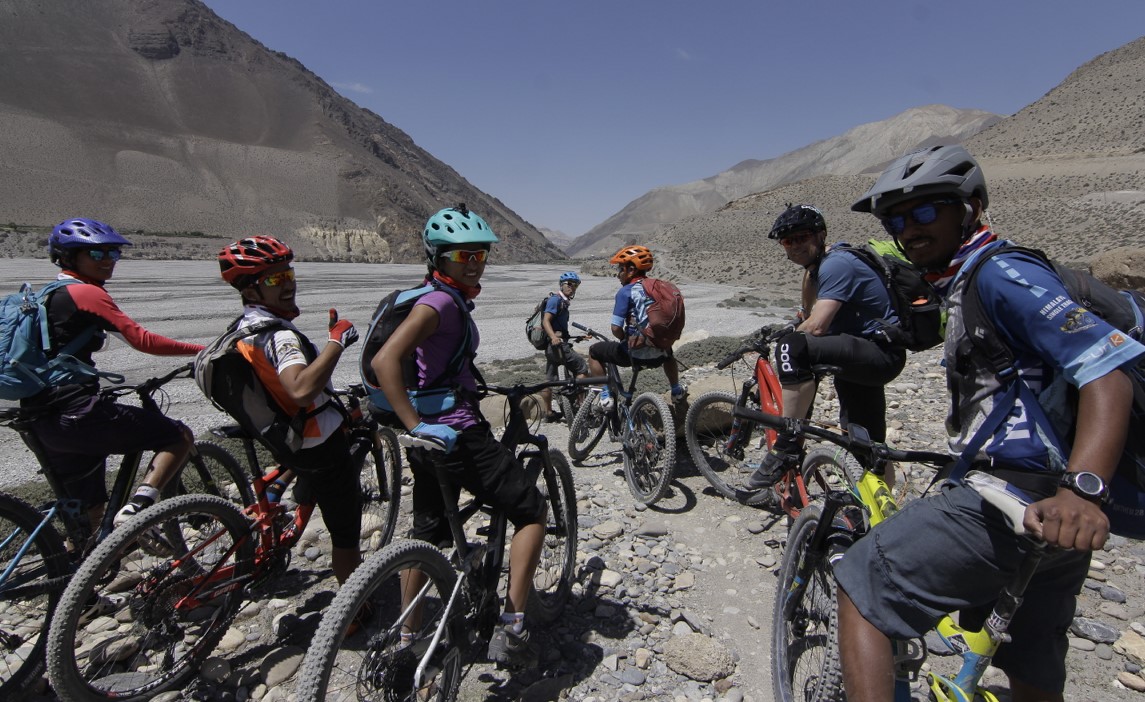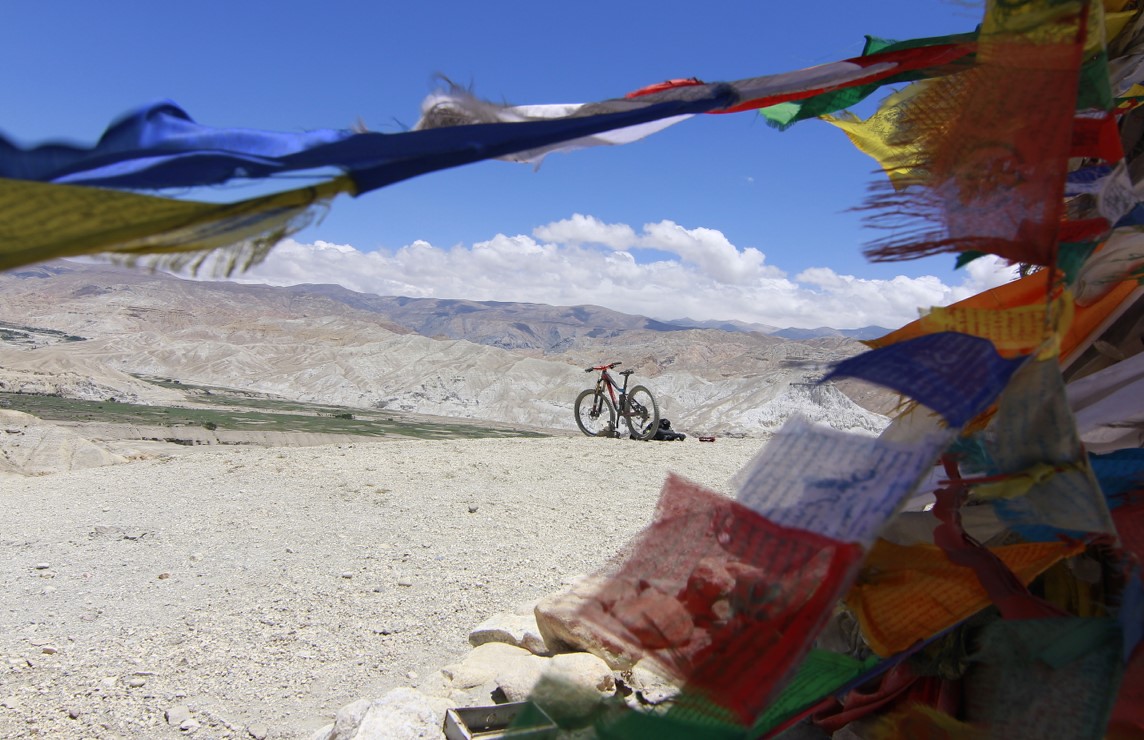Santosh Rai traded his raft paddles for a pair of bicycle pedals 16 years ago, and hasn’t stopped mountain biking since. From exploring the country through the whitewaters to traveling off the beaten track to escaping a near-death experience in the Forbidden Kingdom, Rai's life has been an exhilarating adventure. Now the owner of a mountain biking company, he wants the sports to reach new heights.
Santosh Rai is the founder and co-owner of Himalayan Single Track (HST), a mountain bike company with their own fleet of mountain bikes and required equipment and accessories. It researches, plans, and organizes biking trips to special trails or single tracks to various parts of Nepal. "Himalayan Single Track is not a company, it's a playground for those seeking to experience the thrills and chills of mountain biking," says Rai, grinning cheerfully.
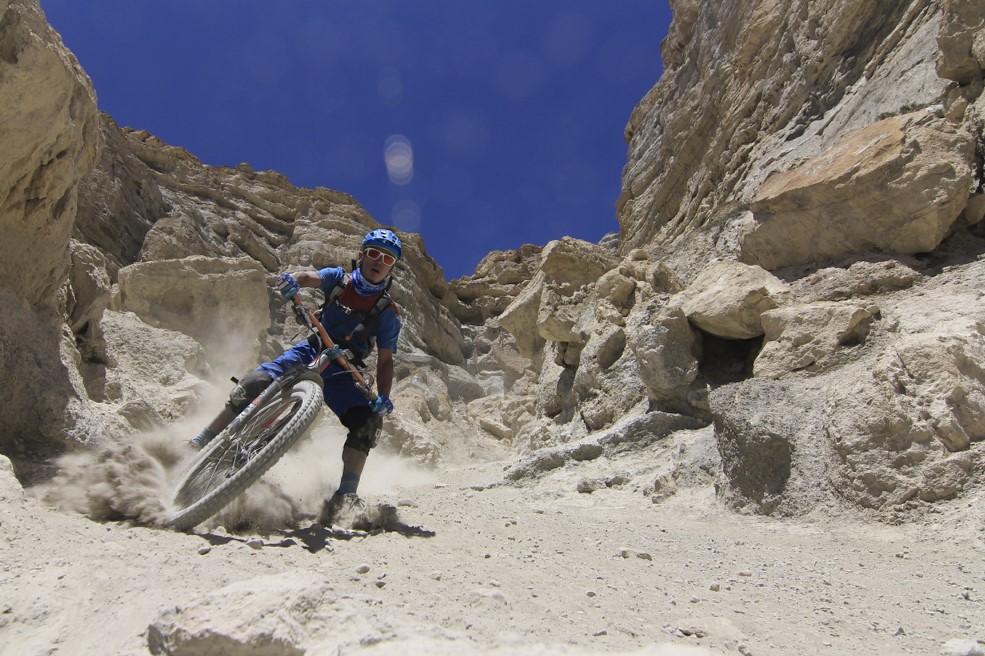
Born in the lap of Makalu, the fifth highest mountain in the world situated in the Sankhuwasawa district, Rai inherited the mountain man spirit from birth. What people call adventure has been his lifestyle. He grew up doing several outdoor activities. His first-ever experience in adventure sports was rafting, having worked three years as a rafting guide. "There are high risks in rafting. Sometimes, the water level goes up, on other days, they go down. There are off-seasons in rafting. But, there are no off-seasons in cycling." When you have a sense of adventure like Rai, only one form of transport can get you to the most stunning locations in Nepal—the bicycle. His first biking experience was in 2002, when he cycled from Kathmandu to Pokhara. A year later, in 2003, he did the Annapurna round trip, and so his journey in mountain biking had well and truly begun. Mountain biking not only gave him the opportunity to travel to many places, but it also gave him an excuse to practice the art of photography, which he calls his second passion.
He's currently preparing for biking to PK Peak. I caught up with him at the HST showroom to talk about mountain biking and his two-wheeled adventures.
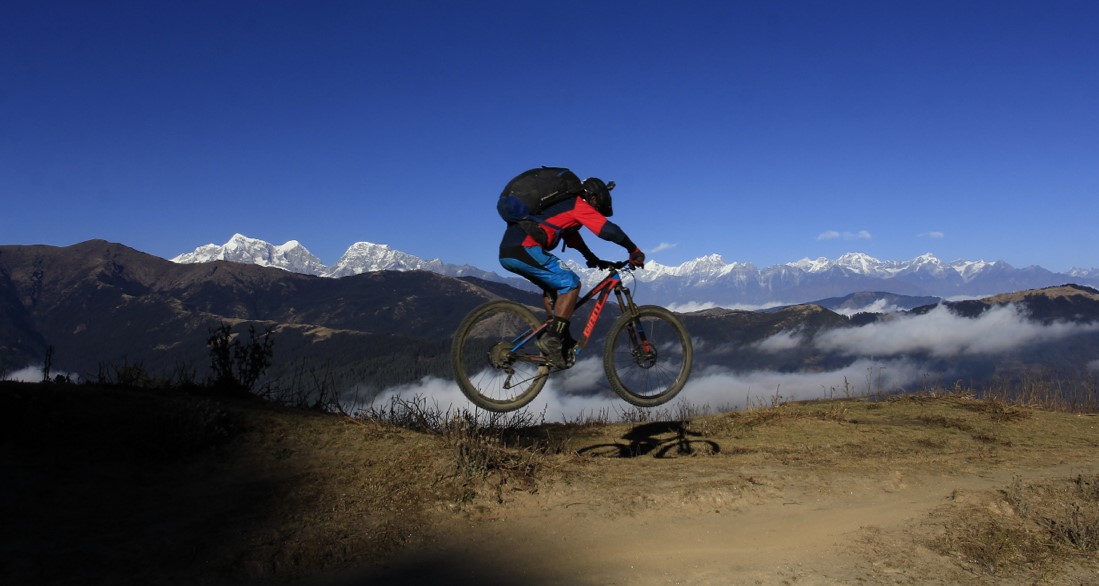
How do you define mountain biking?
Mountain biking is synonymous with Nepal. Nepal is a mountainous country with many peaks. Cycles can't reach the summit of a peak, but they can go wherever a yak can go, including very high altitudes. Technically speaking, mountain biking is a form of cycling, but off the road, with different cycles, gear, and equipment, depending on trails. It is basically cycling on a trekking route. For me, it's a passion. Whenever I get myself a new cycle, I post its photograph on social media as if it's my baby, a new member to the family.
How do you choose where to go?
There is a lot of planning and research that needs to be done before you begin any cycling trip. We have to win the trust of the customers before winning their hearts. The trip should be their money's worth. You need to have local knowledge, knowledge about the demography, the culture, and the geography of the place. The medical history of the riders is also very important to us. The skill and fitness levels of various riders differ considerably. We have to keep encouraging them, supporting them throughout the trip, and maintain good communication.
What were the major challenges of starting a mountain biking company in Nepal?
I worked in Europe for a while. There is a lot of respect there for our profession; there is also the platform to reach your full potential. In Nepal, it is difficult to invest on cycles. I had to initially borrow money to import cycles. We encouraged people to bring their own cycles, because we didn't have many. We told them it would be cheaper if you could bring your own bikes, which used to attract some people. Later we did customization, as well. We brought the frames from China and tires from India. It took two to three weeks to make a bike. The parts weren't easily available, and even those that were available were very expensive.
What is your favorite trail?
There are many destinations for mountain biking that I consider to be my favorite. Scenery-wise, there is no match for Upper Mustang. It is very challenging, but super rewarding. The Annapurna round trip has to be one of my favorites because of the demography and the breathtaking sights, and the challenge the trail brings with it makes it special. For extreme views of the mountains, PK Peak, the Sherpa homeland in Solukhumbu, has to be the best. It is 4200 meters above sea level, and we can reach several destinations from there, such as Okhaldhunga, Salleri, and Ramechhap. It is slowly garnering the popularity it deserves.
Can you tell us a bit about the type of bikes and equipment required on different terrains?
We use different bikes for different trails. ‘Giant’ bike is one of the more popular bikes in our showroom. Shoes, backpacks, and jersey are also very important. We bring in customized jerseys from Israel from a company called Fun Care. Bikes for hire include bikes for hard trail, full suspension enduro, downhill, all-mountain, and the city bike. Most professional riders use full suspension enduro bikes for Nepal, since it is suitable for the rough roads, single tracks, and off-road trails. We customize according to need of the bikers.
Nepalis can carry bikes on their back and walk, so they can ride on most bikes. Since many foreigners come from lower altitudes, they have lesser stamina. There are 15 different tracks in Nepal that we have discovered, and each comes with specific requirements. There are tracks that require skill. To dodge the stones and rocks is a skill. The use of the right gear is also a skill. Helmets, gloves, and sunglasses are extremely important, too.
And, the five most important things in the backpack are?
The five most important things you need to have in your backpack are:
1. Maps or GPS tracking unit
2. Water
3. Patch kid or extra tubes for punctured wheel
4. Air pump
5. Money or food. When you have money, if you find any settlements, you can buy food. There are different types of riders. Some carry ham and cheese with them, while others are willing to do the hard yards. (laughs)
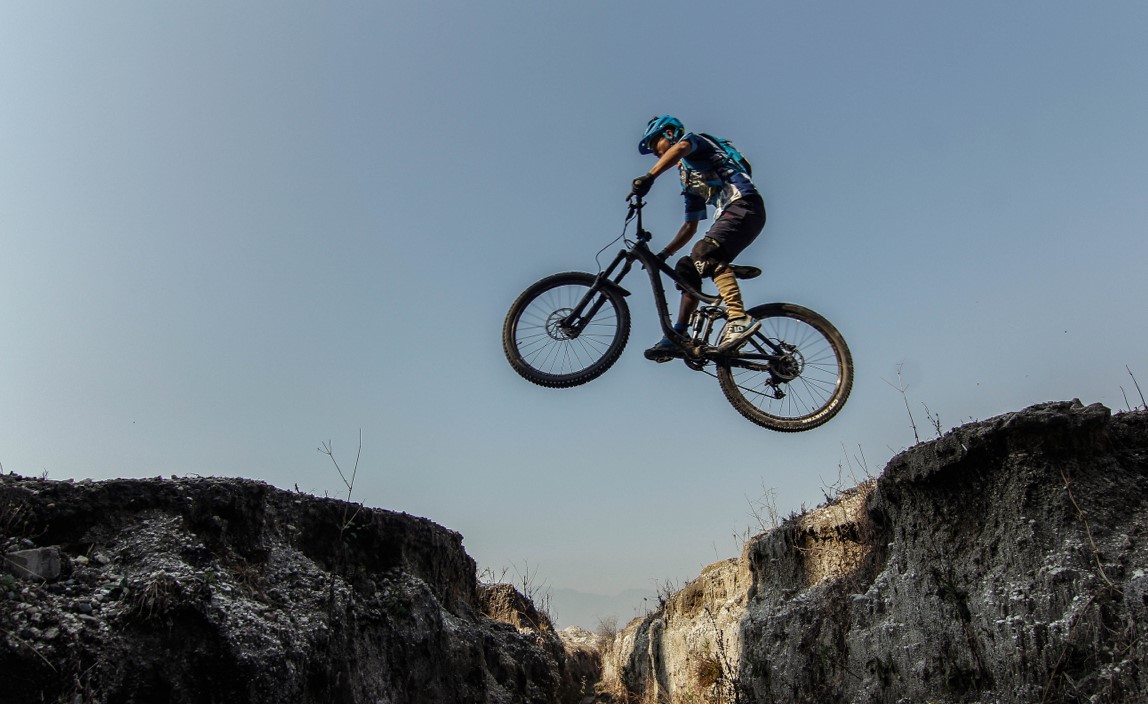 What is the scariest experience you've had?
What is the scariest experience you've had?
Two years ago, while returning from Upper Mustang, I had a nasty accident. It was a near-death experience. It was high altitude cycling, with a strong headwind blowing. I attempted a jump, and the back wheel of my bike separated from the cycle and I took a deadly fall that caused an internal abdominal injury. Since I am a first aid responder myself, I did the things I needed to do. I somehow gathered strength and contacted my colleague, who was able to call a helicopter. I was rescued within 20 minutes; otherwise I wouldn't be here telling you my story. I had two operations and spent a month in a hospital bed.
I was back on my bike in four months’ time. I went cycling to Rara and still felt some pain, but cycling is something that heals me. There are plenty of risks in mountain biking. I believe there is no limit to it, like any other outdoor activity. The most important thing is to know yourself. Know your skills, know your limitations, and know your body. The medical history of the riders is equally important. It makes it easier to communicate, and for the treatment. Helmet, padding, professional equipment that reduce the risk, and first aid box should be carried.
What are the types of trails you provide for the riders?
We provide trails for all kinds of bikers, from weekend travelers to professional riders. The longest rides in terms of time are the Upper Mustang rides, which take 15 to 19 days, and the Annapurna Round, which takes about 10-15 days, depending on the skills and stamina of the riders, of course. We even customize tracks according to skills and needs of the bikers. For example, the Mahabharat range, Dhading besi, and Nuwakot tracks are less risky for people, so it is perfect for amateur riders. Shivapuri is best suited for nature lovers, since it has great views of the mountains. The flora and fauna at the park are magical, too. There is potential to develop hiking, camping, and biking packages in Nagarjuna Shivapuri trail, which has a huge potential, but it is expensive for cyclists. We have been looking to develop the morning ride option around Nagarjuna and Tokha before the vehicles cover the road. The Nepali traffic, however, is a big challenge, especially for foreigners. Recently, I drove around the capital during the Holi festival and found it is so refreshing to ride through the streets of Kathmandu in the absence of vehicles just for a day.
The top trails in the country are?
1. Annapurna round trip
2. Upper Mustang (Pokhara to Jomsom by air or bus, then Kagbeni to north on cycle)
3. PK Peak, Everest region
4. Shivapuri National Park
5. Nagarkot, enduro track (it is suitable even for beginners)
Does HST offer workshops for riders too? Could you tell us about it?
I am a mechanic myself. I learnt the art, and then worked as a mechanic in Israel. I have a good understanding of bikes as a rider, too. Since I have good awareness of the parts and tools, I pass on as much knowledge as I can, but I haven't yet been certified by the government, so it is difficult to conduct workshops without official recognition. However, anyone can come and visit us on Saturdays 9:00 a.m. to 6:30 p.m. at HST for any information about mountain biking. We inform about bike handling and skills required. The government should realize that mountain biking has huge tourism potential and should be promoted internationally.
What is the state of Nepali riders in general?
Nepali cyclists have been flying the Nepali flag around the world for years. Puskar Shah spent 11 years promoting peace, and downhill mountain biker Rajesh Magar has been declared one of the National Geographic adventurers of the year 2018. Nepali cyclists could challenge the best in the world, because they are strong riders who ride on the best tracks in the world, but many of them can't afford to become professional because it is too expensive. There are thousands of trekking companies, but very few cycle companies. There are a lot of accessories, cycles, and gears that are required in cycling, which are difficult to find in the country.
Can you tell us about the women riders?
There are around 50 women riders in the city right now, and the number is likely to increase. Three Sisters company in Pokhara is a great example of women's involvement in trekking. A similar sort of enthusiasm is slowly coming into cycling. Ladies Mountain League is a group of women who came to Nepal from the U.S., and they were involved in various activities to support women mountain bikers. The number of women cycling to colleges or involved community cycling programs are increasing every year. It has also helped the men riders to be more disciplined.
How do you define the relationship of the bikers with nature?
A ride through scenic routes can be one of the most liberating experiences. The tranquil view of nature, freshness of the air, and the sound of the flowing water can be a rejuvenating experience for any rider. But, environmental issues are a major concern for us. Many people take mineral water with them, and when they are finished, they leave the bottles that take 450 years to decay. So, we encourage people to carry water bottles with filters. The knowledge of non-burnable and burnable things, the effect of smoke, is also important. I love nature, and we encourage people to save fuel and take up cycles.
Any advice for upcoming riders?
Mountain biking isn't a race, it's an adventure. So, you are allowed to take your time. You should go with the flow and build your self-confidence. You need to gradually move from easier tracks to more difficult rides. You need to think about your bike, the equipment, apparel, and need to have a strategy. It can get very grueling, as well. You will have flat tires, and you will run out of food. You need to be prepare yourself mentally and physically for everything.
